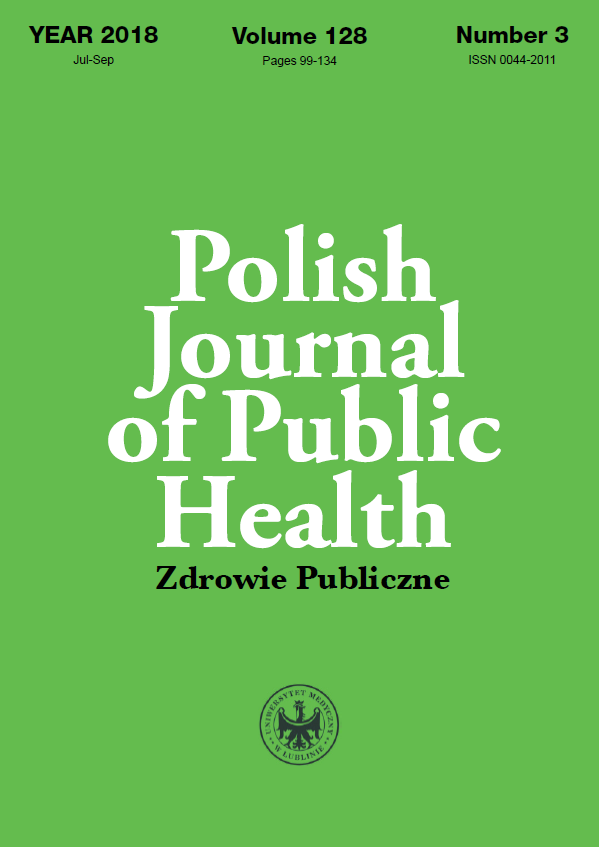Clinical manifestations of neurofibromatosis type 1 – a diagnostic and management challenge
DOI:
https://doi.org/10.2478/pjph-2018-0020Keywords:
autoimmune disorders, epilepsy, neurofibromatosis, thyroid, tumours.Abstract
Introduction. Neurofibromatosis type 1 (NF1), caused by mutation of the tumour-suppressor gene encoding neurofibromin, is an autosomal dominant disorder affecting various organs.
Aim. The aim of the study was to discuss the clinical symptoms of NF1 based on seven cases of the disease with regard to the literature.
Material and methods. We analyzed retrospectively patients with NF1 (4 females and 3 males) aged 19-52 who were treated at Endocrinology Department between 2003 and 2017. The diagnosis was made in childhood (4 patients) or in adolescence (3 cases), based on clinical symptoms and genetic tests.
Results. Five patients had a positive family history of NF1, two cases represented spontaneous mutation. All of analyzed subjects presented café-au-lait spots and neurofibromas on the body. We observed neurological disorders such as: epilepsy (2 patients), Arnold-Chiari malformation (1 man), benign brain neoplasms (2 persons). Optic gliomas appeared in two cases. Tumours were also found in other organs, including the uterus (2 women), the lung, the adrenals, the pituitary and the parathyroid gland (with signs of primary hyperparathyroidism) – each tumour in another patient. Four subjects suffered from cognitive impairment. Skeletal manifestations of neurofibromatosis type 1 such as scoliosis (1 man) and short stature (6 patients) have been noted as well. Five patients presented thyroid disorders – hypothyroidism due to Hashimoto’s disease (4 patients), toxic nodular goiter (1 woman). Other clinical symptoms e.g. vitiligo, alopecia areata and coarctation of aorta have also been found.
Conclusions. Variety of clinical symptoms causes that NF1 still remains a diagnostic and management challenge for many physicians. Therefore, multidisciplinary approach is needed to optimize patients’ treatment.
References
1. Ghalayani P, Saberi Z, Sardari F. Neurofibromatosis type I (von Reckling¬hausen’s disease): a family case report and literature review. Dent Res J (Isfahan). 2012;9:483-8.
2. Dadlani R, Sadanand V, Ghosal N, Hegde SH. Congenital giant plexi¬form neurofibroma with occipital calvarial dysplasia in association with meningoencephalocele in neurofibromatosis Type 1 and segmental neu¬rofibromatosis. J Neurosurg Pediatrics. 2013;12:458-64.
3. Diggs-Andrews KA, Gutmann DH. Modeling cognitive dysfunction in neurofibromatosis-1. Trends Neurosci. 2013;36:237-47.
4. Pasmant E, Vidaud M, Vidaud D, Wolkenstein P. Neurofibromatosis type 1: from genotype to phenotype. J Med Genet. 2012;49:483-9.
5. Crona J, Delgado Verdugo A, Maharjan R, et al. Somatic mutations in H-RAS in sporadic pheochromocytoma and paraganglioma identified by ex¬ome sequencing. J Clin Endocrinol Metab. 2013;98:E1266-71.
6. Nabi J. Neurofibromatosis type 1 associated with Hashimoto’s thyroiditis: coincidence or possible link. Case Rep Neurol Med. 2013; 2013:910656. doi: 10.1155/2013/910656. PubMed PMID: 23691379; PubMed Central PMCID: PMC3652086.
7. Messiaen L, Vogt J, Bengesser K, et al. Mosaic type-1 NF1 microdeletions as a cause of both generalized and segmental neurofibromatosis type-1 (NF1). Hum Mutat. 2011;32:213-9.
8. Ostendorf AP, Gutmann DH, Weisenberg JL. Epilepsy in individuals with neurofibromatosis type I. Epilepsia. 2013;54:1810-4.
9. Zehou O, Fabre E, Zelek L, et al. Chemotherapy for the treatment of ma¬lignant peripheral nerve sheath tumors in neurofibromatosis 1: a 10-year institutional review. Orphanet J Rare. 2013;8:127.
10. Burnichon N, Buffet A, Parfait B, et al. Somatic NF1 inactivation is a frequent event in sporadic pheochromocytoma. Hum Mol Genet. 2012;21:5397-405.
11. Welander J, Söderkvist P, Gimm O. The NF1 gene: a frequent mutational target in sporadic pheochromocytomas and beyond. Endocr Relat Cancer. 2013;20:C13-7.
12. Altinova AE, Toruner F, Cimen AR, et al. The association of neurofibroma¬tosis, bilateral pheochromocytoma and primary hyperparathyroidism. Exp Clin Endocrinol Diabetes. 2007;115:468-70.
13. Güler S, Yeşil G, Önal H. Endocrinological evaluations of a neurofibroma¬tosis type 1 cohort: Is it necessary to evaluate autoimmune thyroiditis in neurofibromatosis type 1? Balkan Med J. 2017;34:522-6.
14. Oderich GS, Sullivan TM, Bower TC, et al. Vascular abnormalities in pa¬tients with neurofibromatosis syndrome type I: clinical spectrum, manage¬ment, and results. J Vasc Surg. 2007;46:475-84.
15. Miraglia E, Fabbrini G, Di Biasi C, et al. Chiari type 1 malformation in Neurofibromatosis type 1: experience of a center and review of the litera¬ture. Clin Ter. 2016;167:e6-10.
16. Hegedus B, Yeh TH, Lee da Y, et al. Neurofibromin regulates somat¬ic growth through the hypothalamic–pituitary axis. Hum Mol Genet. 2008;17:2956-66.
17. Makino K, Kurita N, Kanai M, Kirita M. Spontaneous rupture of a dissect¬ing aneurysm in the superior rectal artery of a patient with neurofibromato¬sis type 1: a case report. J Med Case Rep. 2013;7:249. doi: 10.1186/1752-1947-7-249.
Downloads
Published
Issue
Section
License
Copyright (c) 2019 Polish Journal of Public Health

This work is licensed under a Creative Commons Attribution-NonCommercial-NoDerivatives 3.0 Unported License.


